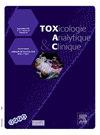Update from the EU Early Warning System on new psychoactive substances
IF 1.7
Q4 TOXICOLOGY
引用次数: 0
Abstract
Aim
The European Union Early Warning System on New Psychoactive Substances (EU EWS), operated by the EU Drug Agency (EUDA) is operational since 1997. It was the first regional early warning system to be established to monitor new psychoactive substances (NPS) and has been recognised as a model for national, regional and international early warning systems.
Method
The EU EWS rapidly detects, assesses and responds to health and social threats caused by NPS. Data collected and analysed include event based data on seizures by law enforcement, collected samples and serious adverse events linked to NPS. These data are complemented by annual reports, which include aggregated data on seizures and from poisonings.
Results
By September 2024, the EUDA was monitoring more than 980 NPS, 26 of which were first reported in 2023. The availability of NPS in Europe has reached a historic high, with more than 41 tons seized in 2023. This increase has been driven by a large increase in seizures of synthetic cathinones, in particular 3-CMC and 2-MMC, mostly trafficked from India. New threats continue to appear, including emergence of semi-synthetic cannabinoids (SSCs) and nitazenes. Since May 2022, 18 SSCs have been identified in Europe, underscoring the market's rapid evolution. They are sold openly in a broad range of consumer product forms, including vapes and edibles. While the available information on harms is limited, an outbreak of poisonings caused by edibles containing SSCs was reported by Hungary. Since 2022, there has been an increase in reports of nitazenes detections and poisonings in parts of Europe, and particularly in Estonia and Latvia. In addition, localised outbreaks of poisonings caused by nitazenes were reported by France and Ireland. The data also suggests an increase in the detection of fake medicines containing nitazene opioids.
Conclusion
Currently, the NPS market is characterised by complexity and increased integration with the market for established controlled drugs. The market is resilient and highly dynamic making it difficult to disrupt. Forensic and toxicological information sources are critically important for but there remains a need for investment in forensic, analytical and toxicological capacity. As of July 2024, the EUDA has a new mandate to implement and coordinate a network of laboratories with the aim of improving the detection capacity and knowledge of NPS, as well as the implementation of a European Drug Alert System (EDAS) for the detection and reporting of drug-related risks. The NPS market is still very dynamic in the EU and these new mechanisms (EUDA Laboratory network and EDAS) are aimed to further strengthen national and EU preparedness and response to NPS.
来自欧盟新精神活性物质预警系统的最新信息
欧盟新精神活性物质预警系统(EU EWS)由欧盟药品管理局(EUDA)运营,自1997年以来一直在运行。这是为监测新的精神活性物质(NPS)而建立的第一个区域预警系统,并已被公认为国家、区域和国际预警系统的典范。方法欧盟EWS快速发现、评估和应对NPS造成的健康和社会威胁。收集和分析的数据包括执法部门缉获的事件数据、收集的样本和与国家养老金计划有关的严重不良事件。这些数据由年度报告补充,其中包括关于癫痫发作和中毒的汇总数据。截至2024年9月,EUDA监测了980多例NPS,其中26例于2023年首次报告。欧洲NPS的可用性达到了历史最高水平,2023年查获了超过41吨。这一增长是由于合成卡西酮缉获量大幅增加,特别是主要从印度贩运的3-CMC和2-MMC。新的威胁不断出现,包括半合成大麻素(ssc)和nitazene的出现。自2022年5月以来,已经在欧洲发现了18个ssc,突显了市场的快速发展。它们以各种消费产品的形式公开出售,包括电子烟和可食用的电子烟。虽然关于危害的现有信息有限,但匈牙利报告了一次由含有ssc的食品引起的中毒事件。自2022年以来,在欧洲部分地区,特别是爱沙尼亚和拉脱维亚,nitazene检测和中毒的报告有所增加。此外,法国和爱尔兰报告了由nitazene引起的局部中毒事件。数据还表明,对含有硝基阿片类药物的假药的检测有所增加。结论目前,NPS市场具有复杂性和与现有管制药物市场日益一体化的特点。市场是有弹性和高度动态的,很难扰乱。法医和毒理学信息源至关重要,但仍然需要对法医、分析和毒理学能力进行投资。自2024年7月起,EUDA将获得一项新的授权,即实施和协调一个实验室网络,旨在提高NPS的检测能力和知识,并实施欧洲药物警报系统(EDAS),以检测和报告药物相关风险。在欧盟,NPS市场仍然非常活跃,这些新机制(EUDA实验室网络和EDAS)旨在进一步加强国家和欧盟对NPS的准备和响应。
本文章由计算机程序翻译,如有差异,请以英文原文为准。
求助全文
约1分钟内获得全文
求助全文

 求助内容:
求助内容: 应助结果提醒方式:
应助结果提醒方式:


